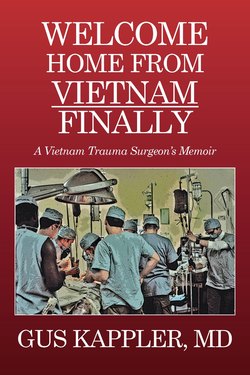Читать книгу Welcome Home From Vietnam, Finally - Gus Kappler MD - Страница 24
На сайте Литреса книга снята с продажи.
85TH COMPOUND
ОглавлениеThe army, in its infinite wisdom, triangulated the 85th Evacuation Hospital with three major targets that the Viet Cong rocketed, usually with poor accuracy, thus increasing the probability of the hospital compound being hit.
85th Evac Compound (nonblurred lower two-thirds of the photo)
These VC enticements were a huge military airport cluttered with lethal Cobra gunships bordering the emergency department and the helipad for the Medivac choppers, a huge communication center, the 8th R&R, officially referred to as the Radio Research Field Station, that triangulated enemy transmissions for targeting by B-52s, and a Military Assistance Command Vietnam (MACV) complex for training the South Vietnamese (ARVN) troops. Rectangular upright revetments made of plywood on the ends, corrugated metal front and back, and chain-link fence green metal posts were filled with sand and stood around the hospital buildings as Stonehenge monuments protecting the patients and staff from red hot lethal flying shrapnel.
Revetments (lower left), ammo dump (far right), and officers’ hooches (last row)
Let me tell you there is nothing so frightening as the whistling scream of the enemy rocket traversing its arch to land who knows where.
As an aside, when first in country, the newbie would hasten to the bunker at the onset of distant canon fire. As time passed, he would enter into the discussion whether the sounds reflected incoming (enemy) or outgoing (friendly) action, then run to the bunker. After a while, having consumed a few drinks in the O Club, which was another plywood shanty on stilts painted forest green, one just recognized the sounds and stayed put knowing there was no safe place if the missile had your name on it.
After passing east off Highway 1 through the MP-guarded gate, the dusty dirt road meandered past the enlisted men’s hooches on the north, several surrounded with revetments built from fifty-five gallon drums filled with sand.
Enlisted hooch with sand-filled fifty-five gallon drums (MACV in the background)
On the west was our ball field and the female nurse’s hooches. Continuing south, one observed easterly the nearby concrete mound-shaped ammo dump, which was labeled in red and white for all to see. The track then turned slightly west toward the Orderly Room from which the compound was governed. It too was protected with army-designed revetments of sand, plywood ends, corrugated metal on the long sides, and green chain-link fence posts.
The dull white building was decorated with scrubby, unhealthy appearing palm trees planted in two-foot high metal troughs, offensively painted a sickly orange red.
That’s the building where I initially had checked in, and it proudly displayed at its entrance the 85th Evac’s shield like crest inscribed with the sentiment “Miracularum Laborantes,” which we not Latin scholars, interpreted as “Miracle Workers.” And we were! If the wounded were alive when they reached the 85th Evac, there was a 95 percent salvage rate.
More westerly of the Orderly Room were the officers’ hooches, which included the docs. Bob, Casey, and I shared a hooch, which had been partitioned into three rooms. The shanty like structure was elevated about two feet on two-by-four stilts to avoid flooding during the monsoons. The walls and sand-roughed floor were constructed of two-by-four’s supporting sheets of plywood. The roof consisted of corrugated metal reinforced with the weight of deteriorating sandbags. Small horizontal screened-in windows below the eves allowed for ventilation.
Our hooch (second from the right), shower (first from the left), and roof of the gym (behind the tree)
Bob and I entered from the front facing the shower and the bunker.
Male nurses and MSC officers
Directly across from us was a hooch of male nurses and Medical Service Corps (MSC) officers. With them we shared an outdoor grill constructed from a fifty-five-gallon drum, blow-touched in half, and elevated on metal tubular legs.
A pathway made from ten-foot-long-by-sixteen-inch-wide pierced steel planks (PSP), partially overgrown by Vietnam’s grasslike vegetation, wandered by the hooch residences. PSP was pierced with multiple three-inch holes in the ten-gauge steel. The perforations decreased weight, facilitated drainage, and added traction, especially for landing aircraft. PSP could vary from sixteen to thirty-eight inches wide and was used for roads, bridges, landing strips, and helipads.
